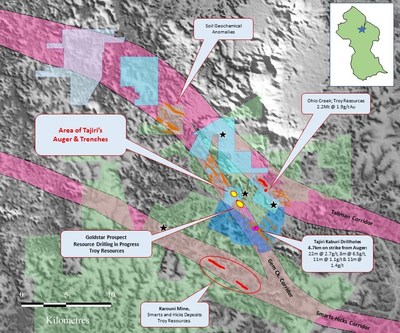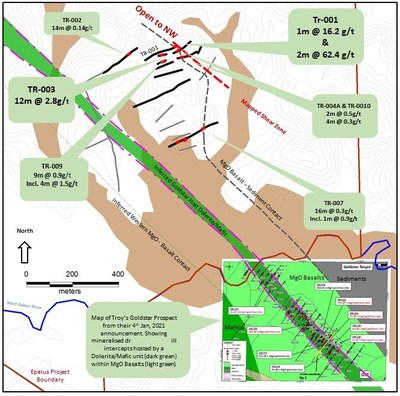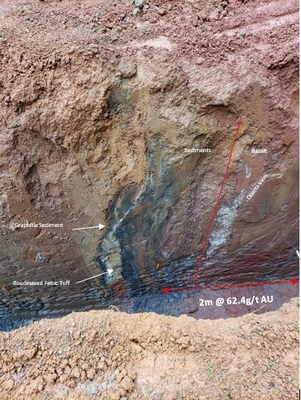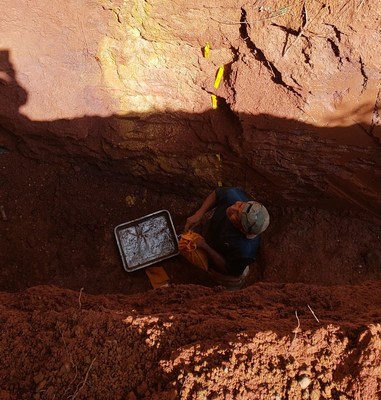Tajiri Hits High Grade 2m @ 62.4 g/t Au at Epeius, Guyana, South America
VANCOUVER, BC, March 10, 2021 /CNW/ - Tajiri Resources Corp. (the "Company") (TSXV: TAJ) is pleased to announce excellent results from continuing trench sampling at the Epeius Project Guyana, South America where trenching is investigating the on-strike potential of ASX listed Troy Resource's Limited's Goldstar Prospect located on the southern boundary of the Project (Figure 1).
The high-grade intersection of 2m @ 62.4 g/t Au was discovered after extending Trench 001 which as previously announced (Jan 07, 2021) had intersected 1m @ 16.2 g/t Au in its last metre. The 2m @ 62.4 g/t is located 10m across strike from the 1m @ 16.2 g/t and between 4 & 6 metres from the eastern end of Trench 001. Thus over an 11m interval the Company has delineated 3m of high-grade gold mineralization averaging 47 g/t Au. The trench is almost orthogonal to the strike of mineralization and thus reported widths are ~ 90% of true.
The two high grade intersections are located on a sub-parallel structure to and approximately 1,000m north of Goldstar (Figure 2). The 2m @ 62.4 g/t Au is situated on a major contact, which can be traced for over 15km, between mafic volcanic rocks and fine grained, variably graphitic, turbiditic sediments. This mineralization is completely open down dip and along strike to the northwest and strike extensions are currently being trenched. Immediately to the southwest the contact has been tested by 4 trenches over a strike length of 400m and has been demonstrated to host persistent but low-grade gold mineralization- peak value 2m @ 0.9 g/t. Furthermore at between 4 and 8 kilometres southeast within the Company's wholly owned Kaburi project the same contact is associated with significant drill intersections (e.g. 22m @ 2.7g/t Au) and soil geochemical anomalism of between 100- 3,450ppb Au.
Significantly, the high-grade intersection reported today is associated with a pronounced mapped strike flexure in the sediment-volcanic contact from N-S to NW (Figure 2) related to a NW striking, 5-20m wide zone of shearing mapped in trenches proximal to the contact in this area. In addition, the observed dip of the contact steepens from 60˚ to 85˚ over a distance of 30m between TR001 & TR004A and the contact exhibits a minor flexure which juxtaposes the shear zone and sediment-volcanic contact in Trench 001. As such the proximity of the contact to a substantial shear zone and the change in "architecture" of the contact into what appears to be the preferred strike orientation of gold deposits in the district (e.g. Smarts, Hicks) can be viewed as favorable for extending this high grade zone.
In detail the 2m @ 62.4g/t is hosted by a zone of high strain and shear fabric development with tight metre scale folding in the sediments with weaker shear fabric development, strong quartz-carbonate veining of up to 30cm thickness and sulphidation (visible as limonite staining) within "doleritic" mafic volcanics at the contact (Figure 3). The zone hosting the 1m @ 16.2g/t Au, 10m west of the sediment-mafic contact mineralization occurs at the contact of two basalt phases a porphyritic-fragmental basalt to the west and the same "doleritic" phase which is in contact with the sediments. This contact between two basalt phases presents as a highly weathered zone of powdery pervasively limonite-stained clay, fine silica and black sand with abundant 50% smokey to milky quartz carbonate stockwork veining of centimetric scale (Figure 4).
Finally, the 2m @ 62.4 g/t interval was initially assayed at Act Labs Guyana Inc. by conventional 30-gram fire assay and checked by a 500-gram screen fire assay. The conventional fire assay returned 61.9 g/t Au whereas the screen fire assay reported 62.4 g/t Au. Gold distribution was approximately equal between fine and coarse fractions with 56% of the gold in the sample reporting to the minus 150-micron (-100 mesh) size fraction which assayed 46.0 g/t and 44% to the +150 micron category which assayed at 179.4 g/t.
Executive Chairman Dominic O'Sullivan commented
"This is our third announcement related to ongoing due diligence assessment at Epeius and with each we have advanced from some early auger hits (Dec 7, 2020) through some "warm-up" trench results (Jan 13-2021) to today's high grade hit in the space of 3 months. I am particularly encouraged in the co-incidence of the two highest grade intervals so far encountered by our program with the change in strike of a regional scale known mineralised contact from N-S to NW and its co-incidence in this area with a significant shear zone. In the wider region the preferred strike elongation of gold deposits such as Hicks, Smarts, Goldstar, Ohio creek is NW (~ 310˚). Furthermore, a general alignment of topographic features (small ravines and slope breaks) is highly suggestive that the strike change associated with mineralisation could persist for up to 1,000m to the NW the direction in which mineralization lies open."
Qualified Person
The Qualified Person under National Instrument 43-101 - Standards of Disclosure for Mineral Projects for this news release is Dominic O'Sullivan a geologist, member of the AusIMM, Executive Chairman of Tajiri and who has reviewed and approved its contents.
On Behalf of the Board,
Tajiri Resources Corp.
Graham Keevil,
President & CEO
About Tajiri
Tajiri Resources Corp. is a junior gold exploration and development Company with exploration assets located in two of the worlds least explored and highly prospective greenstone belts of Burkina Faso, West Africa and Guyana, South America. Lead by a team of industry professionals with a combined 100 plus years' experience the Company continues to generate shareholder value through exploration.
This news release may contain forward-looking statements based on assumptions and judgments of management regarding future events or results. Such statements are subject to a variety of risks and uncertainties which could cause actual events or results to differ materially from those reflected in the forward-looking statements. The Company disclaims any intention or obligation to revise or update such statements.
Neither the TSX Venture Exchange nor its Regulation Services Provider (as that term is defined in the policies of the TSX Venture Exchange) accepts responsibility for the adequacy or accuracy of this release.
SOURCE Tajiri Resources Corp.

![]() View original content to download multimedia: http://www.newswire.ca/en/releases/archive/March2021/10/c1229.html
View original content to download multimedia: http://www.newswire.ca/en/releases/archive/March2021/10/c1229.html



